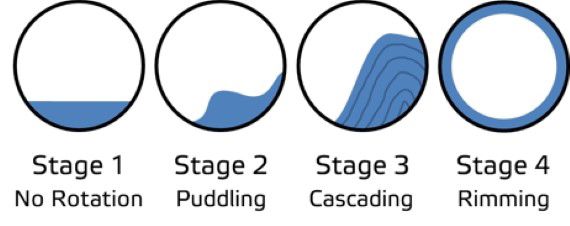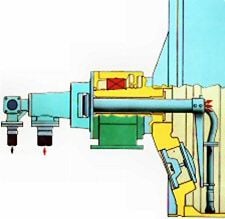Steam & condensate 2 - condensate, heat transfer and maintenance
Aug 4, 2015
In this second part of the series on Steam & Condensate systems, We cover condensate behavior and heat transfer, as well as how syphons are used for condensate removal. Finally, we list the most important maintenance checkpoints for air, steam and condensate systems.
Condensate Behavior and Heat Transfer
Steam is used as the heating medium in a dryer and enters the dryer in a saturated, or near saturated state. As heat is conducted through the dryer shell and into the sheet, the steam is condensed to liquid, giving up its latent heat. The latent heat is the motive heat source for drying paper.

The above figure shows the four main stages of condensate behavior as the dryer rotation speed changes:
- Stage 1 - No rotation. Condensate forms a pool in the bottom of the dryer cylinder.
- Stage 2 - Puddling. As the dryer begins to turn, the puddle moves up with the rotating dryer shell, and a thin film of condensate forms around the shell surface.
- Stage 3 - Cascading. Faster rotation of the dryer causes the puddle to move farther up the shell until gravity forces overcome centrifugal forces and the condensate showers back into the bottom of the dryer.
- Stage 4 - Rimming. As the dryer rotation speed is increased further, centrifugal forces overcome gravity forces so that the film thickness is uniform all around the dryer shell.
The cascading stage offers the best heat transfer because of the very turbulent conditions inside the dryer, but the power surges may cause gear and bearing problems. On high-speed machines, dryer bars are normally used to break up the laminar condensate layer and thus improve heat transfer.
For a given diameter dryer, the speeds at which the above stages occur depend on the amount of condensate in the dryer. As the quantity of condensate in a dryer decreases, rimming will take place at a slower speed. This is important because syphons are more effective in the rimming stage than in the other stages. Most modern machines operate at speeds well above rimming.
Heat is conducted through several layers during the drying process. These include the condensate layer, any scale build-up on the dryer shell inside surface, the cast iron dryer shell, the dirt and/or air gap (if any), and the sheet. All of these layers offer some resistance to heat flow; some more severely than others.
The cast iron dryer shell has a relatively low resistance to heat flow; however, the condensate layer has a high resistance to heat flow. For comparison, a 1" thickness of water (condensate) has approximately 70 times the resistance to heat flow as a 1" thickness of cast iron. Therefore, it is very important that the condensate layer be kept thin so that heat flow will always be at a maximum to dry as much paper as possible.
Condensate Removal

- Stationary - Cantilevered through the journal from outside the dryer cylinder, does not rotate with the dryer, and
- Rotary - Fixed to the dryer shell, rotates with the dryer.
Differential Pressure and Blow-Through Steam
All modern syphons require a certain amount of differential pressure, and blow-though steam to properly evacuate condensate and non-condensable gases (air). Blow-through steam is defined as steam that is "blown through" the dryer, without condensing and thus not giving out its latent heat. For a given set of conditions, there is always a certain relationship between the differential pressure and the amount of blow-through steam. The differential pressure vs. blow-through steam characteristics determine the design of the steam and condensate system. Therefore, it is very important that the condensate layer be kept thin so that heat flow will always be at a maximum to dry as much paper as possible.
Maintaining Air, Steam & Condensate Systems
The following points should be checked yearly. Annual service to the heating and ventilating equipment is usually done during the summer months when very little or no heating of the supply air is required. This ensures that the equipment is in good working condition for the coming heating season.
- Completely check the condition and operation of all the components of the Control System. Service these components regularly: instrument air filter (replace filter cartridge), pressure regulator valves, instrument air pressure gauges, temperature controller (check and calibrate), solenoid valves, damper operators (check and calibrate), steam valve (check and calibrate), air tubes and fittings, electrical wiring and connection.
- Completely check the condition and operation of all the components of the Steam and Condensate Piping System. Service these components regularly: gate valves and shut-off valves, strainers, check valves, pipe insulation, pipe and pipe fittings, pipe hangers, vacuum breakers, steam traps.
- Check the condition of the complete ductwork system. Broken or corroded ductwork should be repaired or replaced. The distribution system should be re-balanced if required.
- Check the condition of the duct hangers and repair where required.
For more information on maintaining your steam & condensate system in optimum working order, contact your Valmet representative.